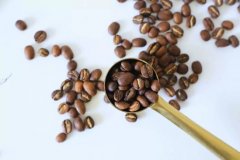How to choose good coffee beans? Three tricks teach you to avoid misunderstandings
How to choose good coffee beans? Three tricks teach you to avoid misunderstandings
Professional coffee knowledge exchange more coffee bean information please follow the coffee workshop (Wechat official account cafe_style)

NO.1 chooses fresh coffee beans
When buying, pay attention to whether the color of the beans and the size of the particles are the same. Good coffee beans are shiny and have a strong aroma without being mixed with peculiar smell. No matter what kind of coffee beans, freshness is an important factor affecting the quality. When shopping, grab one or two coffee beans in your mouth and chew them with a crisp sound (indicating that the coffee is not damp) and the fragrance of the teeth and cheeks is the top grade, but it is best to squeeze it with your hands to feel whether it is solid, rather than buying crispy coffee. If the coffee bean has lost its fragrance or smells stale, it means that the coffee bean is no longer fresh and is not suitable for purchase.
Freshly fried coffee beans are not suitable for immediate consumption and should be stored for a week to completely release the gas from the beans.
Generally speaking, the best drinking period for coffee is a week after stir-frying, when the coffee beans are the freshest and the Aroma taste is the best.
In addition, the purity of coffee beans is also another consideration. The expert candidate for coffee is not necessarily to look at the size of the particles, but to grab a handful of individual coffee beans (Regional Coffee), about dozens of portions, to see whether the color of each single bean is the same, and whether the particles are similar in size and shape, so as to avoid buying shoddy products disguised as mixed beans. But if it is a synthetic bean (Blended Coffee), it is a normal phenomenon that the size and color are different. In addition, heavy heat and medium-deep roasting will cause coffee beans to produce oil, but if the lightly roasted beans produce oil, they have gone bad, not only reducing aroma, but also astringent and sour taste. In short, when buying coffee, we should pay attention to its freshness, aroma and whether it is stale or not, and the ideal purchase quantity is to be able to drink it in half a month.
Judgment of NO.2 shape
Delicious coffee can be known from the shape of its roasted coffee beans, as shown in the following picture. Of course, there can not be bad coffee beans mixed in, it is more important to note that normal beans will also be mixed with high-quality coffee beans and cause hindrance. A fried roasted bean that can brew delicious coffee must first be big and fat, and crepe evenly, followed by the same size and colorless and spotless. These are the main points of visual discrimination, and if you look at them carefully, it should not be difficult to separate them.
Bad bean varieties of NO.3
Fermented beans: coffee beans fermented by falling into the soil before harvest. The moldy smell will have a great impact on the taste of coffee.
Dead beans: also known as unripe beans, or affected by the climate due to red, the development is not sound. Fried spots will be produced after baking, making the coffee have a green and astringent taste.
Black beans: fermented beans, coffee beans that have rotted and blackened. Because it is black, it can be distinguished from normal coffee beans at a glance. Moth beans Coffee beans infested by insects. Defective beans may be stuck during work, or carelessly handled during handling, resulting in incomplete coffee beans. Will cause fried spots when baking, and will produce bitter and astringent taste. Other remaining thin-skinned beans, stunted beans, beans that are not completely moldy when dried, and "shell beans" with only shells.
Important Notice :
前街咖啡 FrontStreet Coffee has moved to new addredd:
FrontStreet Coffee Address: 315,Donghua East Road,GuangZhou
Tel:020 38364473
- Prev

Development and change of Coffee: from Medicinal use to drinking
Coffee for drinking is said to have begun at the beginning of the eleventh century, and the record can be seen in ancient Arab documents. Before that, coffee beans were dried and boiled in the Arab region and then drank as stomach medicine, but later learned that coffee also had a refreshing effect, coupled with the strict Muslim commandments that forbade believers from drinking, and believers used coffee juice from roasting as a substitute for wine.
- Next

What's the difference between macchiato and cappuccino? caramel macchiato and macchiato
Professional coffee knowledge exchange more coffee bean information please follow the coffee workshop (Wechat official account cafe_style) one is coffee macchiato, caffe macchiato, one is milk macchiato, latte macchiato. The so-called coffee macchiato is in an espresso cup, and an espresso can be covered with foam. And milk macchiato
Related
- Beginners will see the "Coffee pull flower" guide!
- What is the difference between ice blog purified milk and ordinary milk coffee?
- Why is the Philippines the largest producer of crops in Liberia?
- For coffee extraction, should the fine powder be retained?
- How does extracted espresso fill pressed powder? How much strength does it take to press the powder?
- How to make jasmine cold extract coffee? Is the jasmine + latte good?
- Will this little toy really make the coffee taste better? How does Lily Drip affect coffee extraction?
- Will the action of slapping the filter cup also affect coffee extraction?
- What's the difference between powder-to-water ratio and powder-to-liquid ratio?
- What is the Ethiopian local species? What does it have to do with Heirloom native species?

